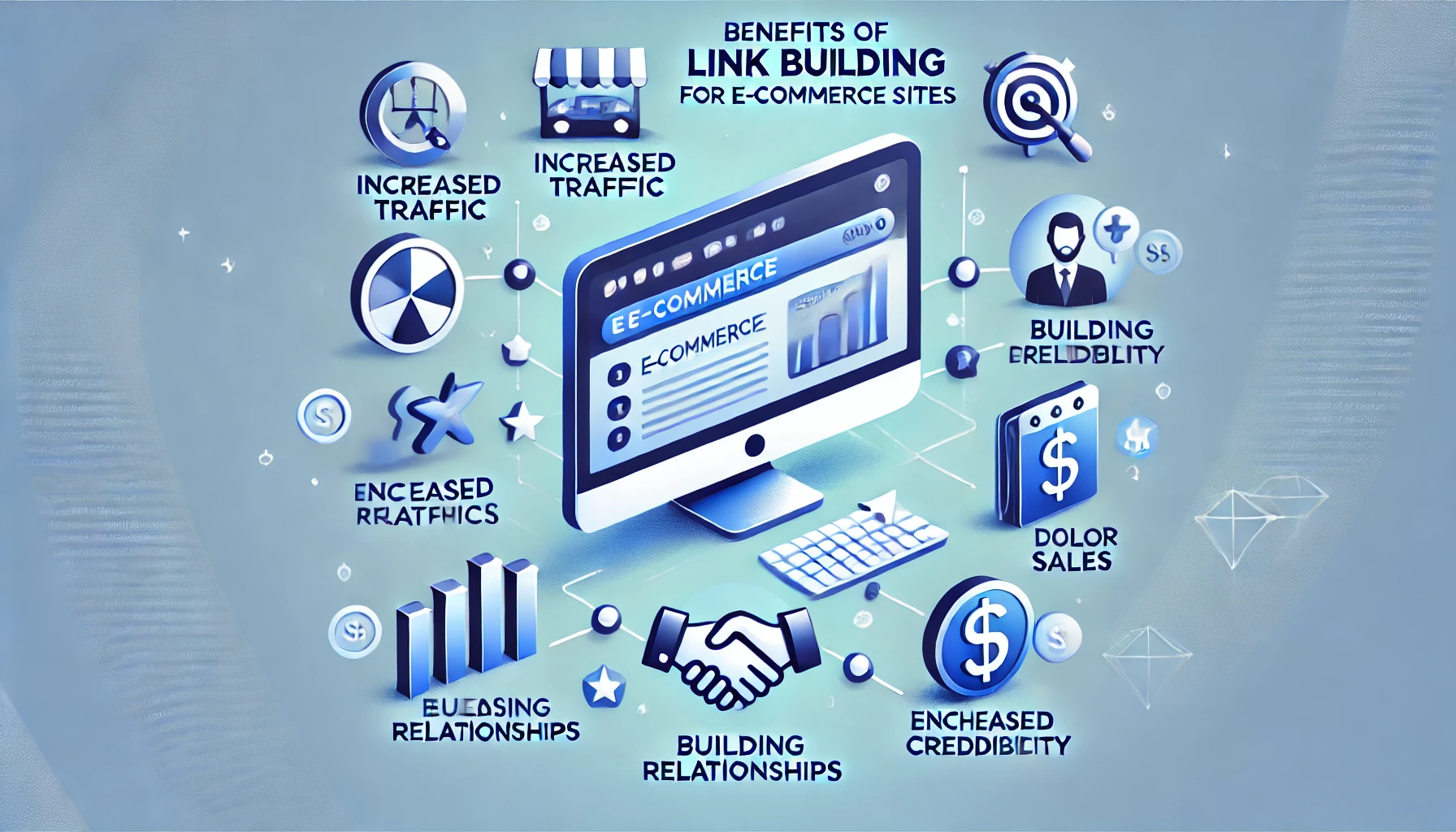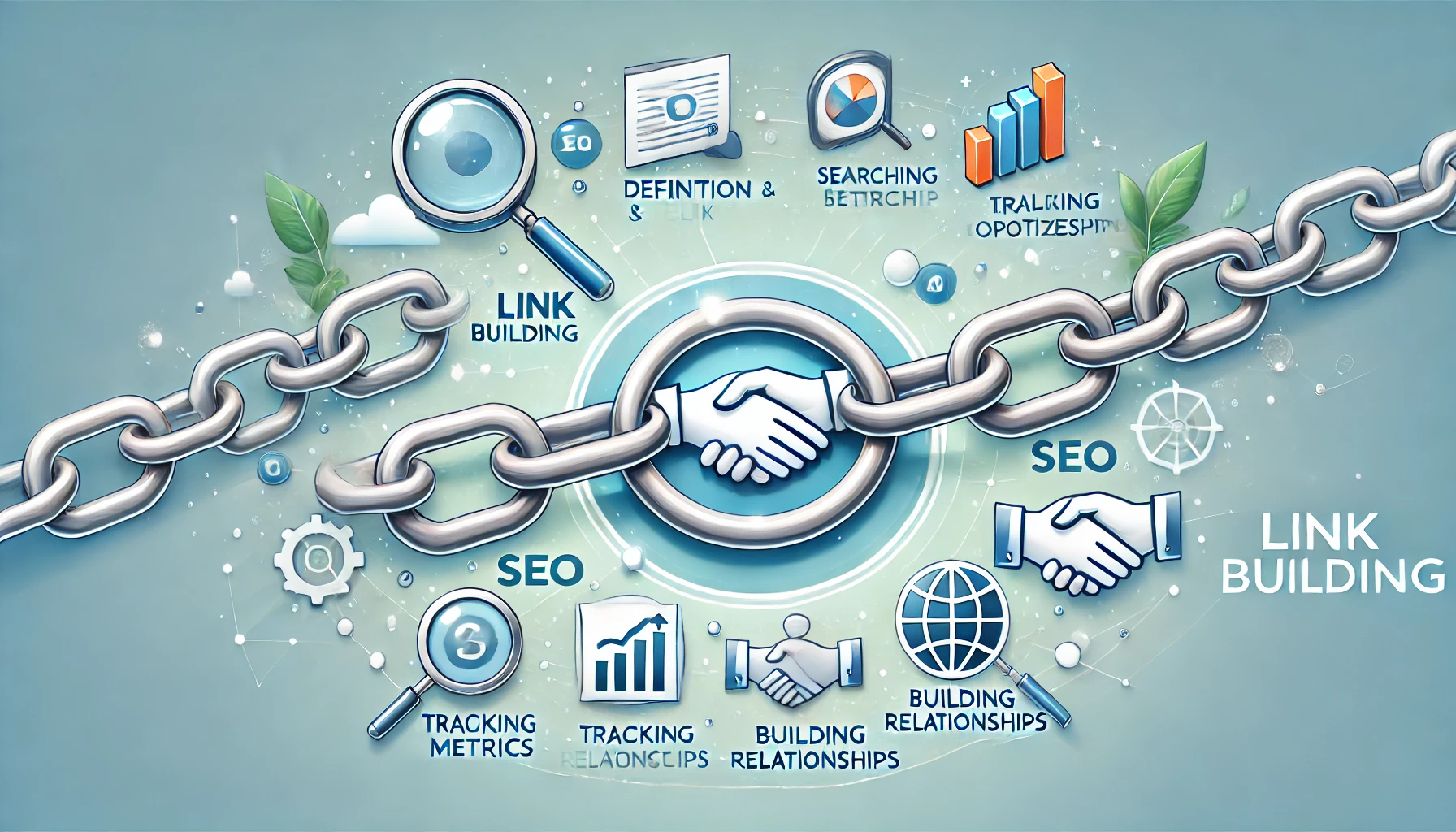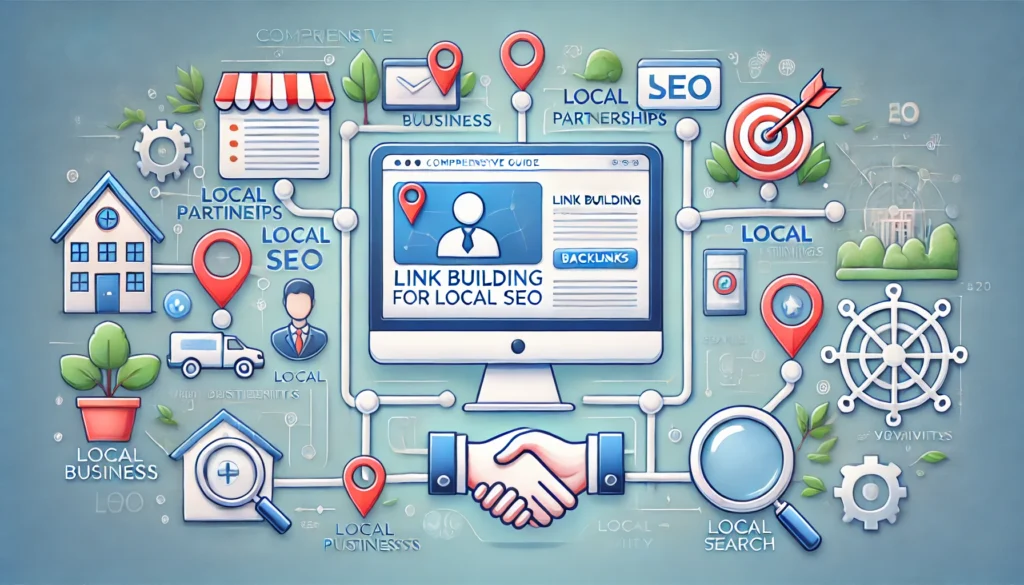Table of Contents
ToggleImportance of Link Building in E-Commerce
In the ever-evolving landscape of e-commerce, standing out in the crowded digital marketplace is crucial. One of the most effective ways to enhance visibility and drive traffic to your e-commerce site is through strategic link building. Link building not only improves your search engine rankings but also establishes your brand’s credibility and authority in the market.
Overview of E-Commerce Marketplaces
E-commerce marketplaces have become the go-to platforms for consumers seeking convenience and variety. These online platforms, ranging from giants like Amazon and eBay to niche-specific marketplaces, provide an ecosystem where buyers and sellers interact. For sellers, having a robust link-building strategy is essential to navigate this competitive environment and attract potential customers.
Benefits of Link Building for E-Commerce Sites

Link building offers numerous benefits for e-commerce sites, including:
- Enhanced Search Engine Visibility: High-quality backlinks are a critical factor in search engine algorithms, helping your site rank higher for relevant keywords.
- Increased Referral Traffic: Links from authoritative sites drive targeted traffic to your e-commerce platform, increasing the chances of conversion.
- Improved Brand Authority and Trust: When reputable websites link to your e-commerce store, it signals to both search engines and consumers that your site is trustworthy and credible.
- Higher Sales and Revenue: With increased visibility and traffic, your chances of converting visitors into paying customers improve, ultimately boosting your sales and revenue.
Importance of Link Building in E-Commerce
Link building is a crucial component of any successful e-commerce strategy. It involves acquiring hyperlinks from other websites to your own, and it’s essential for several reasons:
Enhances Search Engine Rankings
Complex algorithms are used by search engines like Google to evaluate a website’s authority and relevance. High-quality backlinks from reputable sites signal to search engines that your e-commerce site is trustworthy and valuable. This, in turn, boosts your site’s ranking in search engine results pages (SERPs), making it more likely that potential customers will find you when searching for products or services you offer.
Drives Organic Traffic
Links from authoritative websites not only improve your search engine rankings but also drive direct referral traffic. When a reputable site links to your e-commerce store, its audience is more likely to click through to your site, increasing your overall traffic. This influx of targeted visitors can lead to higher conversion rates and more sales.
Builds Brand Authority and Trust
Backlinks from well-known and respected websites lend credibility to your e-commerce store. They serve as endorsements, signalling to potential customers that your brand is trustworthy and reputable. This increased trust can influence purchasing decisions, encouraging more users to buy from your store.
Expands Your Reach
Effective link-building can expose your e-commerce site to new audiences. By securing backlinks from a variety of sources, such as blogs, news sites, and industry-specific platforms, you can reach potential customers who might not have discovered your store otherwise. This broader reach helps to diversify your traffic sources and reduces dependence on any single channel.
Supports Long-Term SEO Success
Unlike some other marketing strategies that provide short-term benefits, link-building offers long-lasting results. High-quality backlinks continue to contribute to your site’s SEO performance over time. As your backlink profile grows and strengthens, your site becomes more resilient to changes in search engine algorithms and competitive pressures.
Overview of E-Commerce Marketplaces
![]()
Definition and Types of E-Commerce Marketplaces
E-commerce marketplaces are online platforms where multiple sellers can list and sell their products to a broad audience. These marketplaces facilitate transactions between buyers and sellers, often providing various services such as payment processing, customer support, and marketing tools. There are several types of e-commerce marketplaces, including:
- B2C (Business-to-Consumer): Platforms like Amazon, eBay, and Walmart, where businesses sell directly to consumers.
- B2B (Business-to-Business): Marketplaces like Alibaba and ThomasNet, where businesses sell products or services to other businesses.
- C2C (Consumer-to-Consumer): Platforms like Etsy and Poshmark, where individual consumers sell to other consumers.
- Niche Marketplaces: Specialized platforms focusing on specific industries or product categories, such as Reverb (musical instruments) or Chewy (pet supplies).
Key Players in the E-Commerce Marketplace Industry
Several major players dominate the e-commerce marketplace industry, each offering unique features and benefits to sellers and buyers:
- Amazon: The largest global e-commerce marketplace, known for its vast product selection, fast shipping, and robust fulfilment network.
- eBay: A pioneer in online auctions and fixed-price sales, offering a diverse range of products from both individuals and businesses.
- Alibaba: The leading B2B marketplace, connecting manufacturers and wholesalers with buyers worldwide.
- Etsy: A popular platform for handmade, vintage, and unique goods, catering to small-scale sellers and artisans.
Benefits of Selling on E-Commerce Marketplaces

For businesses, selling via e-commerce platforms has several benefits, such as:
- Increased Visibility: Marketplaces attract millions of visitors, providing sellers with access to a large and diverse customer base.
- Ease of Entry: Setting up a store on a marketplace is often simpler and faster than building an independent e-commerce website.
- Built-In Trust: Established marketplaces have built-in trust and credibility with consumers, which can help new sellers gain customer confidence more quickly.
- Access to Tools and Services: Marketplaces often offer various tools and services, such as advertising options, analytics, and customer support, to help sellers manage and grow their businesses.
Challenges of Selling on E-Commerce Marketplaces
While there are many benefits, selling on e-commerce marketplaces also presents several challenges:
- High Competition: The popularity of marketplaces means sellers face stiff competition, making it crucial to differentiate their products and offer competitive pricing.
- Fees and Commissions: Marketplaces typically charge fees and commissions on sales, which can impact profit margins.
- Limited Branding Opportunities: Marketplaces often prioritize their branding over individual sellers’, making it harder for businesses to build a distinct brand identity.
- Dependence on Platform Policies: Sellers must adhere to marketplace policies and guidelines, which can change and affect their business operations.
Future Trends in E-Commerce Marketplaces

The e-commerce marketplace industry is continuously evolving, with several key trends shaping its future:
- Mobile Commerce Growth: The increasing use of smartphones for shopping is driving marketplaces to enhance their mobile platforms and apps.
- Personalization and AI: Marketplaces are leveraging artificial intelligence to offer personalized shopping experiences and recommendations.
- Sustainability and Ethical Shopping: There is a growing demand for eco-friendly and ethically sourced products, prompting marketplaces to highlight these offerings.
- Global Expansion: Marketplaces are expanding their reach to new regions and countries, providing sellers with opportunities to tap into emerging markets.
Benefits of Link Building for E-Commerce Sites
Enhanced Search Engine Visibility
One of the primary benefits of link building is improved search engine visibility. High-quality backlinks from reputable sites signal to search engines like Google that your e-commerce site is authoritative and trustworthy. This can significantly boost your site’s ranking on search engine results pages (SERPs), making it easier for potential customers to find you when searching for related products or services.
Increased Referral Traffic
Link building drives referral traffic from other websites directly to your e-commerce site. When authoritative websites link to your store, their audience is more likely to click through to your site, increasing the number of visitors. This targeted traffic often consists of potential customers who are already interested in your products, leading to higher conversion rates and more sales.
Improved Brand Authority and Trust
Securing backlinks from well-known and respected websites helps build your brand’s authority and trustworthiness. These backlinks act as endorsements, indicating that your e-commerce site is a credible source of information or products. This increased trust can influence potential customers’ purchasing decisions, making them more likely to buy from your store.
Higher Sales and Revenue
By enhancing your search engine visibility and driving more targeted traffic to your site, link building can lead to higher sales and increased revenue. The more visitors you attract to your e-commerce store, the greater the opportunity to convert those visitors into paying customers. High-quality backlinks contribute to a more significant online presence, which in turn drives more sales.
Competitive Advantage
In the highly competitive world of e-commerce, having a robust link-building strategy can give you an edge over your competitors. Backlinks from authoritative sites can help you outrank competitors in search engine results, making your products more visible to potential customers. This competitive advantage can be crucial in attracting more customers and growing your market share.
Long-Term SEO Benefits
Unlike some marketing strategies that offer short-term gains, link building provides long-term SEO benefits. High-quality backlinks continue to positively impact your site’s search engine rankings over time. As your backlink profile grows and strengthens, your site becomes more resilient to changes in search engine algorithms and competitive pressures, ensuring sustained traffic and visibility.
Better Indexing by Search Engines
Backlinks also help search engine bots discover and index your e-commerce site more efficiently. When authoritative websites link to your pages, search engine bots are more likely to find and index your content, ensuring that your products appear in search results. This improved indexing can lead to faster and more comprehensive coverage of your site in search engines.
Brand Exposure and Awareness
Effective link-building can increase brand exposure and awareness. By securing backlinks from a variety of sources, such as blogs, news sites, and industry-specific platforms, you can reach new audiences who might not have discovered your store otherwise. This increased exposure can help build your brand and attract more customers to your e-commerce site.
Definition and Basics of Link Building

What is Link Building?
A key component of search engine optimization (SEO) is link building, which is getting links to your website from other websites. These hyperlinks, or backlinks, serve as pathways for users to navigate between different web pages. More importantly, they act as signals to search engines, indicating that your website is a credible and authoritative source of information. The more high-quality backlinks your site has, the better it is likely to perform in search engine rankings.
Types of Links
Link building encompasses various types of links, each serving a unique purpose:
- Inbound Links (Backlinks): These are links from external websites pointing to your site. They are crucial for SEO because they act as votes of confidence from other web entities, boosting your site’s authority and ranking.
- Outbound Links: These are links from your website to external sites. Outbound links can enhance the user experience by directing them to additional valuable resources and can also help in establishing relationships with other web entities.
- Internal links: are those that go between the various pages on your website. Internal links help distribute link equity across your site, improve navigation, and enhance the user experience.
The Basics of Link Building
Effective link-building involves several key steps and best practices:
- Content Creation: High-quality, valuable content is the cornerstone of successful link-building. Creating content that is informative, engaging, and relevant increases the likelihood that other websites will link to it. This includes blog posts, infographics, videos, and comprehensive guides.
- Outreach and Promotion: Building relationships with other website owners, bloggers, and influencers is essential for acquiring backlinks. Outreach involves contacting these individuals and encouraging them to link to your content. Personalized and well-crafted outreach emails are crucial for success.
- Guest blogging: One of the best ways to get backlinks is to write guest posts for respectable websites in your sector. By providing valuable content to other sites, you can include links back to your site, thereby increasing your link profile and visibility.
- Social Media Engagement: Sharing your content on social media platforms can attract attention and potentially lead to backlinks. Engaging with industry communities and groups on social media can also help in building relationships and acquiring links.
- Finding broken links on other websites and providing your material as a substitute is known as “broken link building.” It’s a win-win situation: the website owner fixes their broken link, and you gain a new backlink.
- Competition Analysis: Examining the backlink profiles of your rivals can reveal information about possible avenues for link development. Tools like Ahrefs, SEMrush, and Moz can help you identify where your competitors are getting their backlinks from and replicate their strategies.
Importance of Quality Over Quantity
In link building, quality trumps quantity. Few high-quality backlinks from reputable websites are preferable to a large number of poor-quality links. Search engines, particularly Google, place significant emphasis on the quality and relevance of backlinks. High-quality backlinks come from reputable, relevant, and authoritative websites and are more likely to positively impact your search engine rankings.
Avoiding Black Hat Techniques
Engaging in black hat link-building techniques, such as buying links, participating in link farms, or using automated link-building software, can lead to severe penalties from search engines. These practices violate search engine guidelines and can result in your site being de-indexed or significantly downgraded in search rankings. It’s crucial to focus on ethical, white-hat link-building strategies that comply with search engine guidelines.
Links can be classified as internal, outbound, or inbound.
Inbound Links (Backlinks)
Backlinks, sometimes referred to as inbound links, are links pointing to your website from other websites. These are important links for several reasons.
- Search Engine Ranking: Backlinks are a key factor in search engine algorithms. They serve as testimonials, informing search engines about the authority and credibility of your website. High-quality backlinks can significantly boost your site’s ranking on search engine results pages (SERPs).
- Referral Traffic: Inbound links from reputable sites can drive targeted traffic to your website. This traffic often consists of users interested in your content or products, increasing the chances of conversions and sales.
- Brand Authority: Backlinks from well-known and respected websites enhance your brand’s authority and credibility. They indicate that other trusted entities vouch for your content or offerings.
Outbound Links
Outbound links are hyperlinks from your website to other external sites. While these links direct users away from your site, they serve important purposes:
- Enhancing User Experience: Outbound links can provide additional value to your visitors by directing them to relevant and useful resources. By doing this, you may maintain readers’ interest in your material and enhance their entire user experience.
- Building Relationships: Linking to other reputable websites can help establish relationships with those sites. This can lead to potential collaborations, guest posting opportunities, and even backlinks in return.
- SEO Benefits: Search engines consider outbound links as a sign that your site is part of a larger web ecosystem. Linking to authoritative sources can improve your site’s perceived quality and relevance.
Internal Links
Hyperlinks that connect several pages on your website are called internal links. These links are essential for several reasons:
- Improved Navigation: Internal links help users navigate your website more effectively, making it easier for them to find relevant content and products. A well-structured internal linking system enhances the user experience.
- Distributing Link Equity: Internal links distribute link equity (also known as link juice) across your site. This helps to boost the SEO value of individual pages, making it easier for search engines to index and rank your content.
- Increasing Page Views: By linking to other relevant pages within your site, you encourage users to explore more of your content. This can increase page views, reduce bounce rates, and improve user engagement metrics.
- Context and Relevance: Internal links provide context and relevance to your content. They help search engines understand the relationship between different pages on your site, which can improve your overall SEO performance.
Best Practices for Using Links
To maximize the benefits of inbound, outbound, and internal links, it’s important to follow the best practices:
- Quality Over Quantity: Focus on acquiring high-quality backlinks from reputable sites rather than numerous low-quality links.
- Relevance: Ensure that your outbound and internal links are relevant to the content they are embedded in. This improves user experience and SEO.
- Natural Anchor Text: Use natural and descriptive anchor text for your links. Avoid over-optimization or using generic terms like “click here.”
- Regular Audits: Regularly audit your site’s link profile to identify and fix broken links, remove toxic backlinks, and update outdated links.
- Balance: Maintain a healthy balance between inbound, outbound, and internal links. Each type serves a unique purpose and contributes to your site’s overall SEO health.
Quality vs. Quantity: Importance of High-Quality Links
The argument between quantity and quality in connection with construction is crucial. While it might seem advantageous to accumulate as many links as possible, the reality is that high-quality links far outweigh the benefits of numerous low-quality ones. Here’s why high-quality links are crucial:
What Defines a High-Quality Link?
A high-quality link typically possesses the following characteristics:
- Relevance: The linking site is relevant to your industry or content. Links from sites that share a similar niche or topic are more valuable.
- Authority: The linking site has a high domain authority, which indicates trustworthiness and influence within its niche.
- Trustworthiness: The site has a solid reputation, with a clean link profile free of spammy or unethical practices.
- Natural Anchor Text: The link uses anchor text that is naturally integrated into the content, providing context and enhancing readability.
- Traffic: The linking site receives substantial traffic, which can lead to more referral visitors to your site.
Benefits of High-Quality Links
- Improved Search Engine Rankings
Search engines prioritize the quality of backlinks when determining rankings. High-quality links act as endorsements from reputable sources, signalling to search engines that your site is authoritative and trustworthy. This can lead to higher rankings on search engine results pages (SERPs), increasing your visibility and attracting more organic traffic.
- Increased Referral Traffic
High-quality links from reputable sites drive more targeted referral traffic to your website. Visitors who arrive via these links are often already interested in your content or products, leading to higher engagement rates and a greater likelihood of conversions.
- Enhanced Brand Authority and Trust
Backlinks from authoritative and trustworthy sites boost your brand’s credibility. When users see links to your site from well-known and respected sources, it enhances their perception of your brand, building trust and encouraging them to engage with your content or make purchases.
- Long-Term SEO Benefits
High-quality links provide lasting SEO benefits. Unlike low-quality links that might be penalized or devalued over time, high-quality backlinks continue to contribute to your site’s authority and rankings. This ensures sustained traffic and a robust online presence.
Risks of Low-Quality Links
- Search Engine Penalties
Low-quality links from spammy or irrelevant sites can harm your SEO efforts. Search engines may penalize your site for engaging in manipulative link-building practices, resulting in lower rankings or even removal from search results.
- Poor User Experience
Links from low-quality sites may not drive valuable traffic. Visitors arriving from these links are less likely to be interested in your content, leading to high bounce rates and low engagement. This can negatively impact your site’s overall performance and user experience.
- Wasted Resources
Investing time and resources in acquiring numerous low-quality links yields little to no benefit. Focusing on quality ensures that your efforts are directed toward building a strong, sustainable link profile that delivers long-term value.
Strategies for Acquiring High-Quality Links
- Content creation: Generate valuable, high-quality content that draws links on its own. This includes in-depth articles, infographics, videos, and original research that others want to reference and share.
- Guest Blogging: Write guest posts for reputable sites within your industry. This allows you to earn backlinks from authoritative sources while reaching a broader audience.
- Influencer Outreach: Collaborate with influencers and industry leaders. Their endorsement and links to your site can significantly enhance your link profile and brand credibility.
- Broken Link Building: Identify broken links on authoritative sites and offer your content as a replacement. In addition to giving the website owner value, this gets you a backlink of the highest calibre.
- Competitor Analysis: Analyze your competitors’ backlink profiles to identify high-quality link opportunities. Tools like Ahrefs, SEMrush, and Moz can help you uncover valuable linking sites within your industry.
Successful Link Building Campaigns in E-Commerce
Case Study 1: Glossier
Strategy: Influencer Partnerships and User-Generated Content
Overview: Glossier, a beauty and skincare brand, leveraged influencer partnerships and user-generated content to build a robust backlink profile.
Approach:
- Influencer Collaborations: Glossier collaborated with beauty influencers and bloggers, providing them with products to review and share on their platforms. This resulted in high-quality backlinks from influential beauty blogs and social media profiles.
- User-Generated Content: The brand encouraged customers to share their Glossier experiences on social media using branded hashtags. Many of these posts were featured on Glossier’s website, generating organic backlinks from users’ blogs and social media profiles.
Results:
- Significant increase in high-quality backlinks from reputable beauty and lifestyle sites.
- It enhanced brand visibility and credibility in the beauty industry.
- Increased organic traffic and sales from targeted audiences.
Case Study 2: ASOS
Strategy: Content Marketing and Digital PR
Overview: ASOS, a leading online fashion retailer, implemented a comprehensive content marketing and digital PR strategy to attract backlinks.
Approach:
- Trend Reports and Fashion Guides: ASOS created detailed trend reports and fashion guides, positioning themselves as thought leaders in the fashion industry. Fashion blogs, news sites, and industry publications frequently cited these pieces of content.
- Digital PR Campaigns: ASOS conducted digital PR campaigns, including collaborations with fashion influencers and press releases about new collections and brand milestones. These efforts generated media coverage and backlinks from high-authority sites.
Results:
- Significant growth in backlinks from high-authority fashion and news websites.
- Improved search engine rankings for competitive fashion-related keywords.
- Increased referral traffic and brand authority in the fashion industry.
Case Study 3: Wayfair
Strategy: Data-Driven Content and Outreach
Overview: Wayfair, an online home goods retailer, utilized data-driven content and targeted outreach to build a strong backlink profile.
Approach:
- Data-Driven Content: Wayfair produced content based on proprietary data and industry insights, such as interior design trends and consumer preferences. This content was highly valuable to journalists and bloggers, leading to natural backlinks.
- Targeted Outreach: Wayfair’s team identified and reached out to relevant blogs, news sites, and industry publications, offering their data-driven content as a resource. This proactive approach secured backlinks from authoritative sources.
Results:
- Substantial increase in high-quality backlinks from industry-specific sites and news publications.
- Enhanced visibility and credibility in the home goods and interior design sectors.
- Boosted organic search rankings and increased referral traffic.
Case Study 4: Zappos
Strategy: Comprehensive Resource Pages and Community Engagement
Overview: Zappos, an online shoe and clothing retailer, focused on creating comprehensive resource pages and engaging with their community to attract backlinks.
Approach:
- Resource Pages: Zappos developed in-depth resource pages, such as shoe size guides, fashion tips, and style advice. These pages became valuable references for other sites, leading to organic backlinks.
- Community Engagement: Zappos actively engaged with its customer base through social media, forums, and online communities. This engagement fostered brand loyalty and encouraged users to link back to Zappos’ resources and products.
Results:
- Increased number of high-quality backlinks from fashion blogs, forums, and community sites.
- Improved search engine visibility for targeted keywords related to footwear and fashion advice.
- Strengthened brand loyalty and customer engagement.
Case Study 5: Etsy
Strategy: Seller Support and Educational Content
Overview: Etsy, a marketplace for handmade and vintage items, supported its sellers with educational content and resources, leading to natural backlinks.
Approach:
- Educational Blog Posts: Etsy created a blog with educational content for its sellers, including tips on product photography, marketing strategies, and business management. This content was frequently referenced and linked to by small business and entrepreneurship blogs.
- Seller Success Stories: Etsy featured success stories of its sellers, which were shared widely within the crafting and small business communities, generating organic backlinks.
Results:
- Significant growth in backlinks from small business, entrepreneurship, and crafting blogs.
- Enhanced authority and trust within the handmade and vintage item market.
- Increased organic traffic and improved search engine rankings.
Lessons Learned from Industry Leaders
Successful link-building campaigns from industry leaders in e-commerce offer valuable insights and strategies that can be applied to any business looking to enhance its online presence. Here are some key lessons learned from the best in the industry:
1. Prioritize High-Quality Content
Example: ASOS’s Trend Reports and Fashion Guides
Lesson: Creating high-quality, valuable content is fundamental. ASOS’s detailed trend reports and fashion guides positioned them as thought leaders, leading to numerous backlinks from reputable sites. Make sure the material you provide is interesting, educational, and pertinent to your readers.
Action: Invest in creating comprehensive guides, original research, infographics, and detailed articles that others in your industry will find valuable and worth linking to.
2. Leverage Influencer Partnerships
Example: Glossier’s Influencer Collaborations
Lesson: Partnering with influencers can significantly boost your backlink profile. Glossier’s collaboration with beauty influencers generated high-quality backlinks and increased brand visibility.
Action: Identify influencers in your industry and build relationships with them. Provide them with products or exclusive content they can share with their audience, including backlinks to your site.
3. Engage in Digital PR
Example: Wayfair’s Digital PR Campaigns
Lesson: Proactive outreach and PR efforts can secure valuable media coverage and backlinks. Wayfair’s targeted outreach to industry publications and news sites yielded substantial-high-quality backlinks.
Action: Develop and execute digital PR campaigns. Reach out to journalists, bloggers, and industry publications with newsworthy content, press releases, and exclusive stories.
4. Utilize Data-Driven Content
Example: Wayfair’s Data-Driven Insights
Lesson: Data-driven content is highly attractive to journalists and bloggers. Wayfair’s proprietary data on interior design trends resulted in natural backlinks from reputable sources.
Action: Use data and analytics to create content that offers unique insights or highlights industry trends. Share this content with relevant publications and influencers who might find it valuable.
5. Create Comprehensive Resource Pages
Example: Zappos’ Shoe Size Guides and Style Advice
Lesson: Comprehensive resource pages are valuable linking assets. Zappos’ detailed guides on shoe sizes and fashion tips attracted organic backlinks from various sites.
Action: Develop in-depth resource pages, how-to guides, and FAQ sections on your website. These resources should be authoritative and provide significant value to your audience.
6. Encourage User-Generated Content
Example: Glossier’s User-Generated Content Campaigns
Lesson: User-generated content can lead to organic backlinks and increased engagement. Glossier encouraged customers to share their experiences on social media, which often resulted in backlinks.
Action: Foster a community around your brand. Customers should be encouraged to produce and distribute information about your products. Highlight and feature user-generated content on your site and social media channels.
7. Analyze Competitors’ Backlink Profiles
Lesson: Competitor analysis can uncover valuable link-building opportunities. Understanding where your competitors are getting their backlinks can help you replicate successful strategies.
Action: Use tools like Ahrefs, SEMrush, and Moz to analyze your competitors’ backlink profiles. Identify potential link sources and reach out to these sites with your content or collaboration proposals.
8. Maintain Ethical Link Building Practices
Lesson: Avoid black hat SEO techniques, as they can lead to penalties. High-quality, ethical link-building practices ensure long-term success and sustainability.
Action: Focus on white hat SEO techniques. Build relationships, create valuable content, and engage in legitimate outreach efforts. Avoid link schemes, buying links, or participating in link farms.
9. Diversify Your Link Sources
Lesson: Relying on a diverse range of backlink sources strengthens your link profile. Securing backlinks from various types of sites reduces the risk of being negatively affected by changes in any single source.
Action: Aim to acquire backlinks from a mix of blogs, news sites, industry publications, social media platforms, and forums. This diversification enhances your site’s resilience and authority.
10. Consistently Monitor and Audit Your Link Profile
Lesson: Regularly monitoring your backlink profile helps identify and address any issues promptly. Removing low-quality or harmful links can protect your site’s SEO health.
Action: Conduct regular backlink audits using tools like Google Search Console, Ahrefs, or SEMrush. Identify and disavow toxic links and ensure your backlink profile remains healthy and strong.
Conclusion
In the highly competitive e-commerce landscape, effective link-building is a critical strategy for enhancing online visibility, driving targeted traffic, and establishing brand authority. By examining successful link-building campaigns from industry leaders, we can distil several key lessons that can be applied to any e-commerce business.





